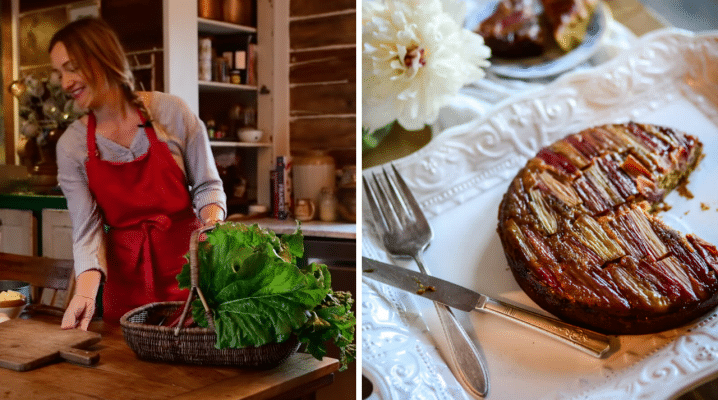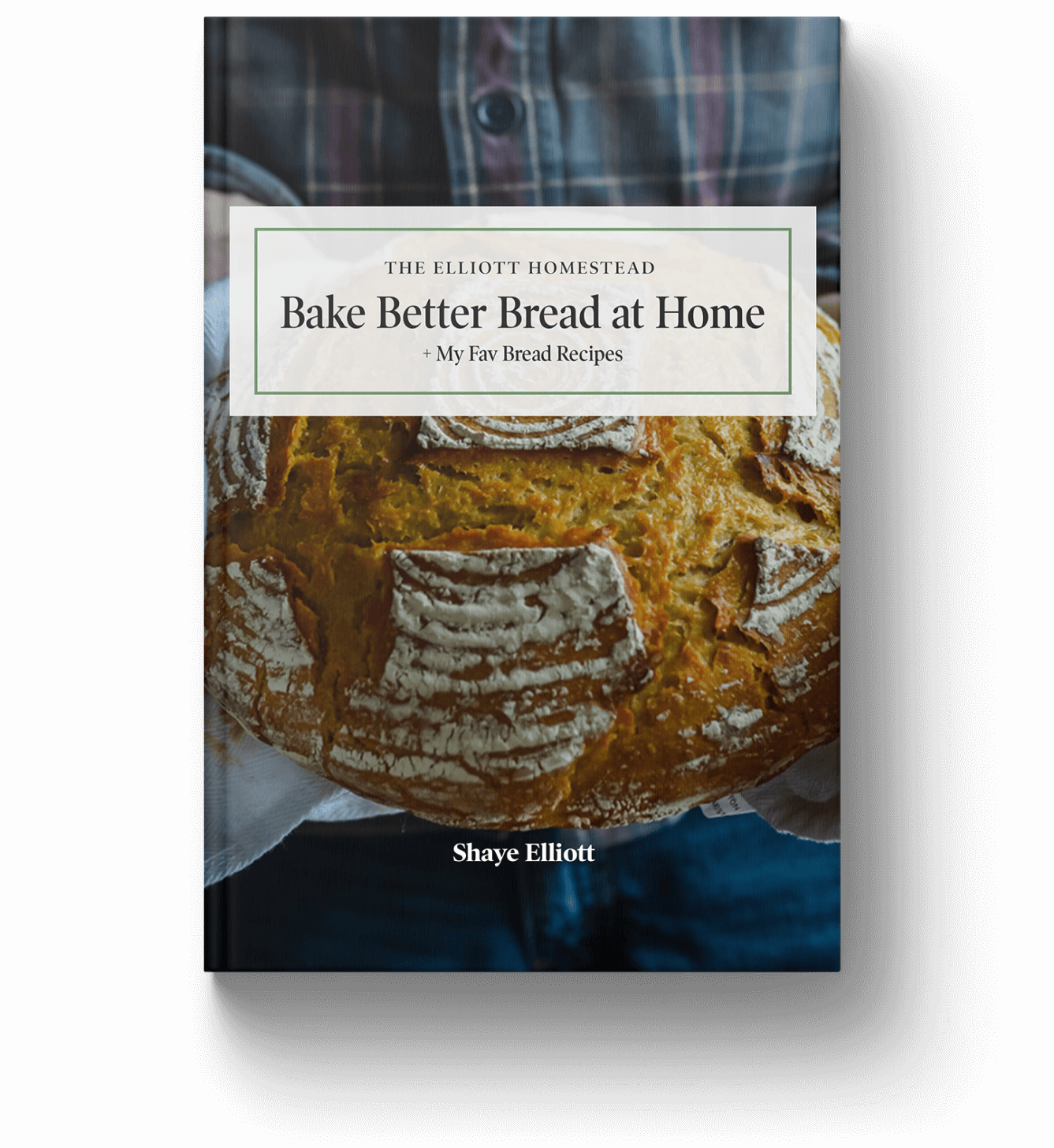I was taught to make this sourdough starter by Carla of Jovial Foods. She taught me how keeping a dry sourdough starter wastes a lot less flour and provides a much more consistent bread. If your sourdough starter has disappointed you in the past (or if you're brand new to having a sourdough starter) give this method a try and let me know what you think!
Dry Sourdough Starter
- Water
- Flour
Day 1
Mix 60g flour and 45g water.
Pick up in hands, work for 30 seconds. Place back in bowl, cover with plasic wrap.
Keep at room temperature for 48 hours.
Day 3
Add 30g of water and 60g of flour. Mix.
Cover for 24 hours.
Day 4
Add 30g of water and 60g of flour. Mix.
Cover for 24 hours.
Day 5
Refresh Starter.
Take out 10g.
Add 30g water and 60g flour.
Mix and put in tuperwear or glass mason jar with lid.
Wait 6-10 hours at room temperature until dough bubbles.
If you don't see any bubbles, refresh on Day 6 and repeat if nessisary.





I was looking for the bread recipe that you said would be posted down below, and couldn’t find it…is there any way you can email it to me? I’ve been struggling with Mary Jane Butter’s sourdough starter for six weeks, and I’m ready to give the dry starter a try. Just need a proper bread recipe….I love your YouTube channel! Will probably be purchasing some books from you in the near future.
Best,
Heather
I’m going to try the dry starter. I only bake every couple of weeks. How long can the dry starter sit in refrigerator before it has to be refreshed?
Thank you. Hope to hear from you via email. I love the concept of this starter.
Hello! She said she refreshes it weekly
I am so glad that there is a dry starter now. I uses to make it when the kids were small. I am having trouble getting to the recipe.
Heather, I found the everyday bread recipe in the show notes on YouTube.
https://www.youtube.com/watch?v=0zHW2chG27Q&feature=emb_logo
The bread recipe is below the video if you view it in You Tube.
As of day 4 my dry starter is very “liquidity “ is this normal? 2. Can’t find bread recipe that was to follow dry starter video & how often fo you feed the refrigerated starter& what’s the ratio. As I’m sure you can tell I am very new at this but very determined. Thank you in advance for any info!
I’m on day 8 and nothing is happening. Should I start over or keep at it? (I think it got too cold in my house one of the nights)
Hey Heather,
The recipe is posted in the shownotes below the video on the Youtube page not this page.
Would this be a good way to take on the plane (one day’s travel) in an insulated bag with blue ice? I did that method with my regular sourdough starter and it exploded because of the pressure I’m sure but I had enough left to bake with. Ideas?
What if in 48 hours your starter has light pink areas on top . Is it hooch ? Or mold ? Is this normal ?
Hey, Kim. I’m not affiliated with the blog in any way, but I’m a certified baker and if your starter has pink spots it’s mold and needs to be thrown out. Anything pink, black or fuzzy needs to throw out.
Sometimes starters will produce a greyish liquid or get a slightly grey tinge in the beginning stages, but if there’s no spots of anything growing it’s fine.
I couldn’t see the video or the article. It’s missing on my computer screen, I love this idea could you share with me please? Thanks!
i did not see the the bread recipe under the dry sourdough video. can you please advise?
Look where she puts her links and under them it will say “more…” click on more and it will show the rest. May have to scroll down a little. It isn’t easy to see but it’s there.
Hello,
I can’t keep my house above 65, and putting it in the oven makes it grow mold in the first 48 hours. Any thoughts on how to make this work?
Are you using fresh flour? It needs to be fresh for yeast to thrive or there isn’t enough for the yeast to eat so to speak. And then you get mold.
Could you turn on your dryer with towel in it for about 10 minutes and then wrap your starter in a towel and sit it in the dryer with the door cracked open? You can take the starters temperature to see how it responds some have also said boiling water in your microwave warms it up and you can put the starter in there
Good morning! I really appreciate your video, and I started my starter on Monday. This morning is day 5, so I pulled the 10 grams out to do the first refresh. I have two questions: 1) is the 10 grams + water and flour that is now in the lidded container the official starter? And if so, 2) what is the amount left behind….the mixture that has been growing for 5 days? Does that mixture just get discarded? It had some good bubbles in it yesterday and today. I am hoping I can use it for something! Thank you so much.
I started my starter on Saturdayy. This morning is day 5, I made a mistake and I continued to do the same as day 5, and then only on day 6 I pulled the 10 grams out to do the first refresh.
I have worked out that the 10 grams + water and flour… is now the official dry dough starter Is this correct?
I now have all the other sour dough starer from Day 1- 5 as a left over amount< What am I to do with this?
Do I discard this mixture or use it?
I am now a little lost on how to complete the Bread Recipe to make "real good sour dough bread".
I am hard of hearing – so it was difficult for me to hear everything – so I want to say, thank you for putting "sub-titles" on to what you were adding each time. However – subtitles to all your video's would be great for the hearing impaired.
It took me the whole day to listen, listen and listen again to work out your Video, stop and start, sometimes re-start to try and write down what I need to do to enjoy this sour bread dough recipe. My eyes are my ears.
I am super excited to make sour bread dough, I love making bread – hope I receive a reply shortly.
Have a Blessed Day
Judy Harnden
After I took the 10grams out to refresh my starter, I made pizza crust out of what was left. It was so good.
I have these exact questions and can’t seem to get an answer. Any luck?
This has been puzzling me for days and I was praying someone else would have the same question!! 🤦♀️ What happens to the remainder of the starter after the first 10g is removed etc? Thank you would love some feedback 😊
I made dry sourdough starter using Shea’s recipe from a wet starter that was given to me. I have been using it now for about five months. I love it. After you pinch off 10grams from your dry starter to make an active starter, you just cover the dry starter and put it back in the refrigerator. I bake about once a week. I have kept the dry starter up to four weeks before needing to make new starter or what some would call refresh my starter. One time after I was out of town for two weeks it got just a little slimy on the bottom; so I just pinched off the slimy part and made a new starter. It turned out just fine. I have found recipes from Little Spoon Farm to be very explicit.She usually tells you how much starter to pinch off to make just the right amount of active starter for a recipe. Many of her recipes use 1/2 cup of active starter. So I pinch off 15g of my dry starter and add 50g of flour and 50g of spring water to make the 1/2 cup required for the dough. I put the dry starter back in the refrigerator until I need it again. Hope this helps.
If I have a wet sourdough, can I convert it to a dry one by just changing the amount that I’m feeding it? I would love to try this method!
I found out on Epicurious that you can convert a wet sourdough to a dry sourdough! I’m excited to try that tomorrow. Here’s what they said: A liquid starter can be converted to a stiff starter by adding an appropriate amount of flour. For every 1 cup (8.5 ounces/240 grams) of liquid starter, add 3/4 cup (4.2 ounces/120 grams) flour.
Thanks Shaye for all that you do – I’ve tried a few of your recipes and I’m having fun!
I have the same question! Did you try it? Please let me know.
For anyone reading this later, I did try converting my wet starter to a dry version and it worked! I believe I just started feeding it the higher flour-to-water ratio. Eventually, it became more like a dry starter.
Thanks for all of your wonderful recipes. Just a quick question…in the everyday einkorn recipe, is it 120G of water and 130g of flour, or 130g of water and 120g of flour? I printed what was included with your YouTube video and it used the former amounts, then printed your ecookbook, which used the other. Thank you!
Hi Shaye,
Questions:
1. how long can the “dry” starter stay in the fridge without being fed?
2. what happens when you only have a little bit of “dry” starter left?
3. how long does it need to be on the counter before you can bake etc.- in other words after you prepare the starter for baking?
Thanks ahead
I assume it’s like other refrigerator starters and needs to be freshed at least once a week or once every two weeks.
Make sure the little bit you talked about is at least 10grams so you can use that to refresh. That 10grams starts you next batch so you don’t have to start the process over again.
Hello! Just started day 1 of the starter but I am confused on a couple things. Could you please clarify since it worked for you?
I really want this to work haha
1.) I don’t understand how I get a full container of starter from 10g of product? How do I grow it if I’m continually discarding?
2.) Also after I refresh it weekly do I add that amount back to the amount in the Tupperware? (Otherwise how does it grow it’ll just always be 10g)
Would really appreciate the clarification!
Briana, I had the same questions as you did and my first go at the starter failed miserably. I went to the Jovial website and they described the Day 5 in detail: DAY 5
Today is the first day you will refresh your starter, which you will repeat once a day until it rises up and forms bubbles within 6 to 12 hours. That may happen after a few days, or it may take longer. This is where the patience comes in, as the process does vary from kitchen to kitchen. People always ask, “how will I know when my starter is ready?” Until you see your starter bubbling in this time frame (6-10 hours), your starter is not ready for baking bread.
Until your starter is strong, you will only use a small piece to refresh from Day 5 onward (just 2 teaspoons or 10 g) and discard the rest. It may seem wasteful, but using a small amount of starter is important to help maintain the correct ratio of flour to water. Otherwise, refreshing large pieces of starter would be even more wasteful.
If you want to bake bread before your starter is ready, it will help to move along the entire process of strengthening your starter by cultivating wild yeasts in your kitchen. Simply bake einkorn bread using a recipe made with active dry yeast, but add up to a ½ cup (120g) of the excess starter that you were going to discard to the dough.
REFRESHING YOUR STARTER
Instructions
Place the starter in a small bowl. Add warm water and mix until the starter is dissolved and the water is creamy. Add flour and mix with a fork until most of the flour is absorbed. Roll the starter between your hands until the flour is absorbed, rubbing the bowl with the starter to pick up remaining flour. Transfer the starter to a sealed glass container and let rest at room temperature for up to 24 hours.
Watch closely each day as the bubbles will increase and the activity of the starter will become more apparent. As it becomes more active, the amount and size of the bubbles in the starter will increase significantly and will change the appearance of the starter. It will spread out and the surface will seem pitted. When the starter rises up and doubles in size after 6 to 10 hours, you are ready to bake bread!
Once your starter is ready and your bread is rising nicely, you can refrigerate the starter. When you want to bake bread, remove the quantity needed and use it cold from the refrigerator to mix up the bread recipe. Leave the remaining starter in the refrigerator, and when it becomes low, use the recipe from Day 5 to refresh and replenish the starter, always letting the starter rise after refreshing for 6 to 10 hours. For the first six months, you should refresh your starter once a week to keep it strong. After six months to a year has passed, you can leave it refrigerated for longer. As you keep baking bread, your starter will eventually become mature and will be strong enough to bubble up within 6 to 10 hours.
Thank you!!! This was so helpful!
This was great information thank you. It answered so many questions
What is the ratio for einkorn whole grain? 45g water to 48g of einkorn whole gain? Jovial says 45g water to 60g al propose einkorn or 48g whole grain. It’s a bit sticker than what it looks in the video. Just curious because whole grain is all I have.
Hi there I am getting ready to start my own starter and was wondering what to do with the excess started on Day 5. Can this be used like other discard and made into things or can you start multiple starters from this?
On day 5 do I throw out the rest of the wild yeast starter or can I use it for something?
Can spelt flour be used in place of einkorn to make this sourdough starter? Is so, does the water to flour proportions change?
Thank you
Barb
Hi! I tried the dry starter and it was so easy – but then it quit working. How long will it keep in the fridge? What care does it need?
The more you use it, the better it will be! I try to refresh mine at least once a week and I bake from it multiple times a week. That being said, it’ll keep in the fridge quite awhile.
How do you refresh it after day 5? What gets added to the dry starter?
I have kept a sourdough starter for the past 50 plus years and I am eager to make your dry starter! I would love to try your everyday bread recipe! Thank you so much.
From The Elliot Homestead YOUTUBE:
🥖My EVERYDAY EINKORN BREAD RECIPE:
30 grams sourdough starter
130 grams warm water
120 grams all-purpose einkorn flour
315 grams warm water
400 grams all-purpose einkorn flour
200 grams whole-grain einkorn flour (or whole grain flour of choice)
2 teaspoons salt
1. For the levain, combine the sourdough starter, 120 grams of water, and 130 grams of all-purpose einkorn flour together in a large non-metallic bowl. Use a fork to combine until smooth. Cover the bowl with plastic wrap and set aside in a warm place for 3 hours until small bubbles begin to appear on the surface.
2. After that time, add in 315 grams of warm water to the levain. Stir to combine. Add in the 400 grams of all-purpose einkorn flour, 200 grams of whole-grain einkorn flour, and salt. Use a wooden spoon or stiff spatula to combine. Cover the bowl with plastic wrap again and set aside for fifteen minutes.
3. Dump the bowl contents onto a gently floured marble slab. Use a dough scraper to fold the dough in on itself from each side. Place the bowl upside down over the dough and let it rest for another fifteen minutes.
Repeat the dough scraping and folding once more. Again, place the bowl upside down over the dough and let it rest another fifteen minutes.
Repeat the dough scraping and folding once more. This time, transfer the dough back into the bowl, cover tightly with plastic wrap, and set aside for four hours to proof.
4. Preheat a Dutch oven and it’s lid in a 475-degree oven for 1 hour.
While the oven is preheating, use a bowl scraper (or mason jar lid) to scrape the proofed dough onto a gently floured cutting board. Gently shape the dough by grabbing the edges of the dough and pressing them back into the center with your fingertips. Transfer the loaf to a heavily floured proofing basket. Cover the basket with plastic wrap and let proof at room temperature for 1 hour.
5. When you’re ready to bake the bread, remove the Dutch oven from the hot oven. Remove the lid. Carefully flip the proofing basket into the Dutch oven to transfer the bread in. Cut the top with a razor blade or sharp knife if desired. Replace the lid and bake for 30 minutes. Remove the lid and bake for an additional 15 minutes until the bread is deeply golden and sounds hollow when tapped.
6. Remove the Dutch oven from the oven and remove the bread to a wire cooling rack. Let cool for at least an hour before slicing.
Thank you!!
Please clarify the amount of water and flour because in the recipe, the amounts are reversed from each other.
Hello there!!! I’m at day 5 of the starter where I just refreshed it but I find my ball is very dry and was actually hard to mix up. Now it’s this firm little ball in my glass container.
I also don’t understand how I get a full container of starter from 100g of product? I’m assuming that all those glorious bubbles are going to grow this ball and fill up my container but it all seems so dry and stiff. 🤷🏼♀️ Please help, I really want this to be successful!
First of all, I’m not sure what your definition of a “full container” is; 6 oz? 10 oz? 1 qt? But in any case, you are probably not going to have that. You are only going to have a small amoubt of starter, because it us “dry”, not with all the water. You are nit going to need 1/3 or 1/2 cup of starter to bake bread; you will only use 10 grams (about a tablespoon) of starter to make your bread. If you look at the rectangular dish she is holding in her hand on the video, THAT is her starter. All of it.
The video explains it all.
Ahh yes! I had the same problem! Day 5 gave me a dry, hard ball of dough. So day six I just repeated day 5’s instructions but added more water till it was like thick pancake batter. We will see how it is tomorrow. I might have to start over 😫
I have always loved sourdough bread. I have purchased books trying to be better at baking it. I just haven’t gotten it right. More like bricks than soft chewy crusty loveliness of good sourdough. I can make yeast bread really well. So not a novice at bread baking , But sourdough always was another thing. Finally, after using your dry sour dough and your whole wheat bread recipe, I have made the best sourdough ever! Thank you so much. I look forward to finding more recipes to use my new sourdough!
Hello! Just started day 1 of the starter but I am confused on a couple things. Could you please clarify since it worked for you?
I really want this to work haha
1.) I don’t understand how I get a full container of starter from 10g of product?
2.) when I refresh it weekly do I add that amount back to the amount already in the Tupperware? (Otherwise how does it grow it’ll just always be 10g)
Super confused 😞 if you could answer I would appreciate that so much!
I agree. Instructions need a major edit. The first time I “refreshed” in the instructions above, I took out the 10g and added the 30/60 to this 10g. Now as I am doing it for the second time, I think it may mean add the 30/60 to the jar and discard the 10g. No idea at this point but I am sure wasting good flour.
What I got from this is that once you have created your dry starter, you keep it refrigerated in an airtight container. When you want to make sourdough, you remove 10g, add flour and water to that 10g to make your bread.
You put the remaining dry starter back in the fridge and just keep doing that until you only have 10g or a little more of your dry starter left. At that point, you refresh your starter the same as you did on day 5.
Before I refreshed my starter it was doing great. Now I am on day 9 of refreshing and it has an unpleasant smell, is very dry all though it does seem to have a few bubbles. I tried dropping a small teaspoon full in room temperature water and it falls to the bottom. I am measuring as instructed so not sure what I am doing wrong. Is it normal to have to refresh to day 9?
I currently have a wet start that’s at least 20 years old and gifted from a from. I would hate to let that go, and was hoping that I could transition it into a dry starter. Would that be possible?!?
Your method for a starter is so different from Carla’s and I am so confused.
I’m brand new at doing this. Questions: 1. Can you make the dry starter out of whole grain flour? What is the difference between whole grain flour and all-purpose flour? Can you interchange them? The Everyday Einkorn bread recipe ingredients say 215 g warm water where the instructions say 315 g, which is right? If I grind my own berries, making it a whole grain flour, how does that change the recipe?
I started the dry starter today.
Thank you so much.
You can make the starter out of any kind of whole grain flour (wheat, rye, rice, etc,) that you prefer (but not purpose for this recipe); she happens to prefer the Einkorn brand whole wheat. Use Google to find the difference between whole wheat, all purpose, cake flour, etc. It would be an awful lot to explain here and it can already be found on many sites through Google.
Shayw, thank you SO much fir your dry starter recipe!! I am new to sourdough, but was not going to last long with all those feedings!
Tomorrow will be my day 5, and my question is if it isn’t “right” after 6-10 hours, what is it I refresh? 10 more grams from the original batch, or do I refresh the new batch I created on the morning of day 5?
(Open to response by anybody who knows!)
Thank you!
I am loving this starter!!! It has been an absolute game-changer!! FINALLY, getting consistent results in my sourdough!
Does anyone know, can this dry starter be frozen? And what would be the process for freezing it (does it get fed first?) and using after frozen?
Is it ok if I leave my dry starter just on the counter instead in the fridge. One of my dry starts got a tiny bit of mold on it because of the condensation.
I’ve been using this ‘dry’ sour dough starter for around a year now and I love it! It makes the best breads ever and my family loves it. It’s so much less fuss, easy to use and I will never go back to a wet sour dough starter. I’ve given out pieces to friends and family to share the joy of sour dough baking. I’ve taught a few friends and family members how to make sour dough bread and it has helped me learn more as well.
Love the tips, thanks. Good spelling makes better baking 😎 so please … “necessary” … not what you wrote 🥰
I am about 29 hours in on my starter and it looks very grayish with dark speckles throughout. Is this normal? I’m trying to hit that 48 hour mark but I don’t know if I should discard and start over?